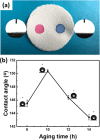Free-Standing Sodium Titanate Ultralong Nanotube Membrane with Oil-Water Separation, Self-Cleaning, and Photocatalysis Properties
- PMID: 31993805
- PMCID: PMC6987293
- DOI: 10.1186/s11671-020-3255-9
Free-Standing Sodium Titanate Ultralong Nanotube Membrane with Oil-Water Separation, Self-Cleaning, and Photocatalysis Properties
Abstract
In this work, a free-standing sodium titanate ultralong nanotube membrane for multifunctional water purification has been prepared. For obtaining this free-standing membrane with good tenacity, one-dimensional (1D) sodium titanate ultralong nanotubes with a diameter of about 48 nm and length of hundreds of micrometers were prepared from TiO2 nanoparticles by a stirring hydrothermal method, which can be easily assembled into 2D membranes by facile vacuum filtration. After modified with methyltrimethoxysilane (MTMS), the free-standing membrane with hydrophobic surface possesses oil-water separation, self-cleaning and photocatalytic functions at the same time, which is favorable for the recovery of membrane and decontamination of various pollutants including oils, dust, and organic dyes from water. Furthermore, this membrane also exhibits excellent alkaline, acid, and corrosive salt resistance. This free-standing sodium titanate membrane with multifunction has potential applications in efficient wastewater purification and environmental remediation.
Keywords: Free-standing; Oil-water separation; Photocatalysis; Self-cleaning; Sodium titanate ultralong nanotubes.
Conflict of interest statement
The authors declare that they have no competing interests.
Figures









References
-
- Kajitvichyanukul P, Hung Y-TH, Wang LK. Membrane technologies for oil-water separation. In: Hung Y-T, Wang LK, editors. Handbook of Environmental Engineering, Vol 13: Membrane and desalination technologies. New York: The Humana Press Inc.; 2011. pp. 639–668.
-
- Razali M, Kim JF, Attfield M, et al. Sustainable wastewater treatment and recycling in membrane manufacturing. Green Chem. 2015;17:5196. doi: 10.1039/C5GC01937K. - DOI
Grants and funding
LinkOut - more resources
Full Text Sources

